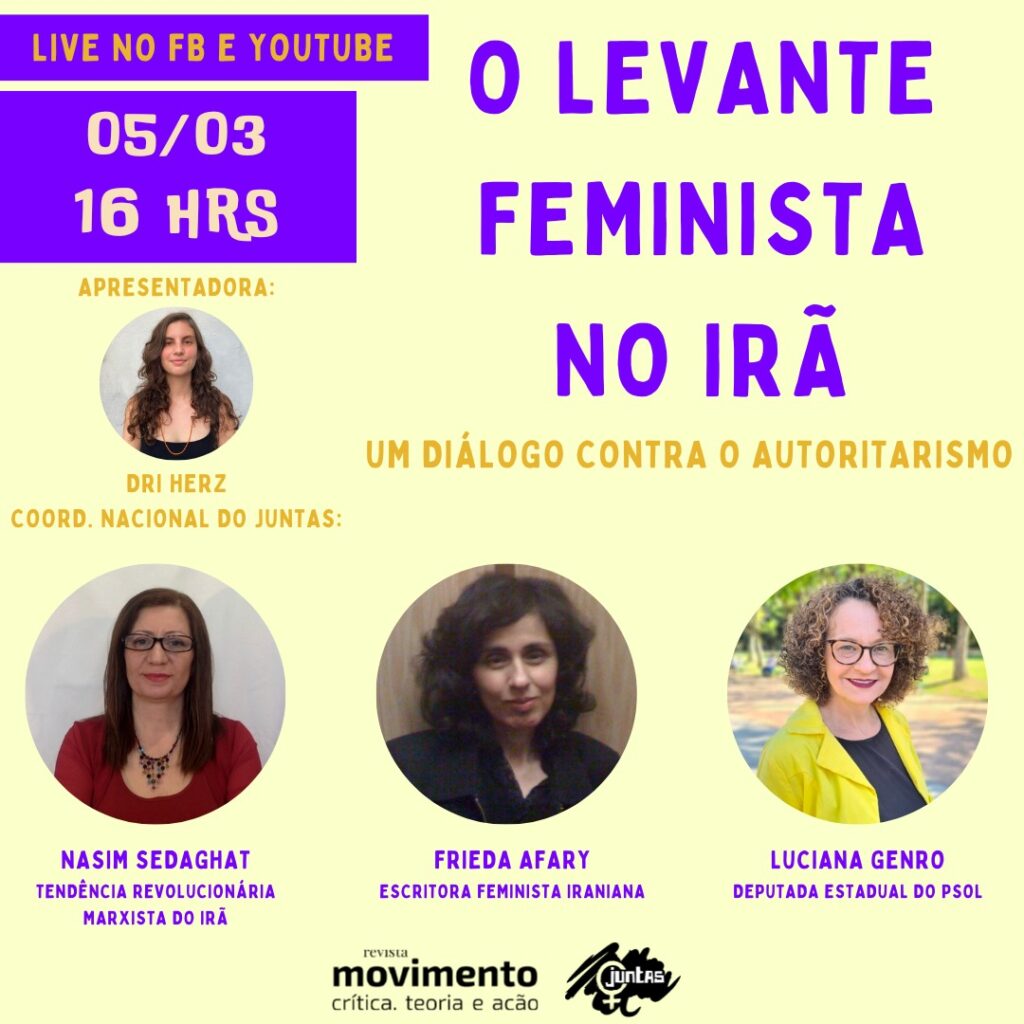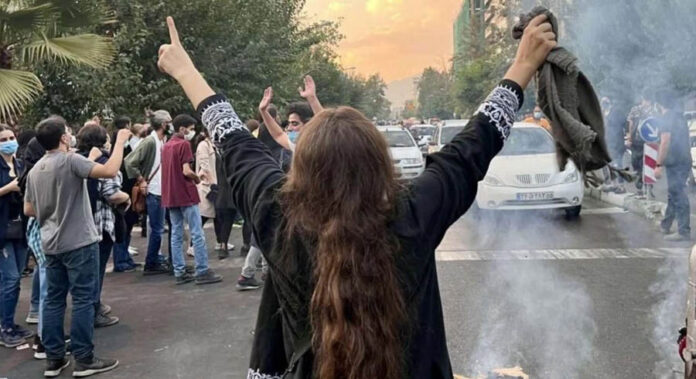On March 5th, 2023, the Movement of Socialist Left (MES) organisation in Brazil organised a meeting on the role of women in the recent protests in Iran and the perspectives for women’s struggles in the next revolution. Nasim Sedaghat, of the Iranian Revolutionary Marxists’ Tendency, Frieda Afary, the author of Socialist Feminism: A New Approach, and Luciana Genro, one of the founders of the Socialism and Freedom Party (PSOL) and a State Deputy in Rio Grande do Sul, took part in “The feminist revolution in Iran: Women against authoritarianism” discussion.

Below we publish the text of Nasim Sedaghat’s speech. Nasim is an ex-political prisoner in Iran who, as a teenager, participated in Iranian revolution 1979. She is currently living in Canada.
***
I send my warm 8th of March greetings to all comrades who fight for women’s rights and liberation. I also thank the comrades of the Movement of Socialist Left for inviting me – as a representative of the Iranian Revolutionary Marxists’ Tendency. I will talk about women’s central role in Iran’s recent protests and their part in the struggle to overthrow capitalism and establish a workers’ state.
On September 16th 2022, Mahsa (Jina) Amini, a 22-year-old Kurdish woman, died after her beating by the Iranian regime’s so-called ‘morality police’. Her state killing sparked off the most significant and sustained protest movements in the history of the current regime. There was bold and heroic action taken by Iran’s youth, national minorities and many other layers. Workers in many industries went on strike – including the oil, gas and petrochemical sector based in Khuzestan.
But it was the defiance and protests of women, particularly young women, with their brave and selfless struggles that gave this uprising such an explosive and radical character. Iran’s fearless women, who took to the streets in unprecedented numbers, motivated millions of people from all classes and layers throughout the country to confront the blood-soaked capitalist dictatorship. In this uprising, women were the first to protest and had a central part in the street and university demonstrations. Tens of thousands of schoolgirls were also widely active inside their schools and in their neighbourhoods. They even chased regime officials out of their schools!
Why did women and girls play this militant role? In Iran, as in every capitalist country, the status of women depends on the general balance of class forces. Historic victories of the proletariat against the bourgeoisie always open the way for women’s struggles. During the 1979 revolution women were active in the workers’ movement, both as striking teachers and nurses, but also as workers in workshops and factories. They were also involved in the guerrilla groups, students’ organisations and other movements fighting the Shah’s dictatorship.
But the counter-revolution of 1981 hit Iranian women’s rights and progress very hard. The new despotism drove their legal rights and social engagement back by about 80 years! The defeat of the revolution allowed the building of a legal, political and social structure that systematically and viciously discriminates against women and girls. As well as general segregation and the compulsory hejab, there are thousands of other inequalities like child marriages, harsher exploitation at work and worse medical care than for men.
The killing of Jina triggered a level of activity that created a big crisis for the regime. To smash this revolutionary situation, therefore, the regime’s repressive measures have been especially harsh against young women: shooting their eyes and genitals, torture and rape in prison, threats against their families and so on. We’ve also seen how much the regime’s hates the militancy of girls. The recent gas poisonings in a number of girls’ schools are acts of revenge for these children’s activism so far – and a warning against future protests! The regime knows that this is one group that will never support it, or even trust it!
Yet the experience of the past four decades shows that despite heavy-handed brutality, living with the capitalist crisis and corruption has led to many movements for social justice and democratic rights. These have brought many women, particularly young students, on to the streets – demanding everything from their lost votes, for the de-segregation and de-militarisation of universities, and against the hejab.
Of course, it is the revitalised workers’ struggles of the past few years that show us the most promising prospect for working-class women and all women and girls in Iran. The militancy of the new workers’ strikes, and particularly the very active role of women in them, has been very significant. For example, women have been involved in organising and leading the Haft Tappeh Sugar Cane Company’s strikes. Women activists have also used tactics like blocking roads, supporting the families and communities of strikers and organising protests outside government buildings.
These struggles show us the best way to get rid of discrimination in the labour market, including unemployment, as well as wider society. They have promoted workers’ unity – male and female – in workers’ organisations and actions. That is the only way to fight the inequality that capitalists and their state promote.
Unfortunately, the revolutionary wave is now subsiding. But clearly the level of discontent in all of society, and particularly among women and girls, will continue and even grow. Eventually the relatively quiet disobedience and resistance will turn into open anti-regime activity. And we can be sure that the level of women’s involvement and activity in all movements – whether as workers, students and in all walks of life – will be higher than ever before.
When the next inevitable revolutionary upsurge takes place, women will definitely be building their own independent organisations. They will obviously formulate their own policies and take independent action to gain their demands. But they will also play their full role in building the mass organisations of workers, students, national minorities, LGBT+ people, writers and artists, and so on. And during the months – and perhaps years – of preparation for the next revolutionary opening, women’s participation in building underground action cells in factories and workplaces, in universities and neighbourhoods, will be crucial.
The most important task facing the working class, women and all exploited and oppressed layers, is to ensure that the consciousness and experiences gained during the latest struggles and strikes are not lost. Only clandestine action cells can preserve the recent gains in the long-term and link the lessons of this uprising to future struggles in every industry and in all provinces. We need more organisations like the Khuzestan Vanguard Socialist Workers’ Cell. There is also a women workers’ cell in Khuzestan which deals with women’s democratic rights, in particular the forced marriage of 11-year-old girls. These clandestine cells are necessary for building towards a general strike – a significant step on the road to overthrowing this regime and the capitalist state.
And, of course, the most conscious and militant workers and women will also be a key part in building a vanguard party. A workers’ vanguard party is the main guarantor of combining the new struggles with the historic gains and theories from movements in Iran and across the world. It will mobilise all classes and layers who want to overthrow capitalism and establish a workers’ state in Iran. Revolutionary Marxist women have an essential role to play in building the vanguard party of the proletariat.
Women workers are a vital section of the Iranian working class. They hold the key to liberating themselves and all other women and girls. To become the most radical tendency within the women’s movement, socialist women workers and socialist female students have to pose transitional slogans that raise the consciousness of female activists in their fight against the current regime and the capitalist system. As well as control over our bodies, sexual relations and how we dress; these demands must include an end to child marriages, an end to so-called ‘honour killings’; the right to full legal equality and an end to all social discrimination; equal pay and access to jobs; free abortion and contraception on demand; free 24-hour nurseries; and socialisation of domestic work.
Long live socialism! Long live women’s liberation!
Woman, Life, Freedom, and a Workers’ Republic!



